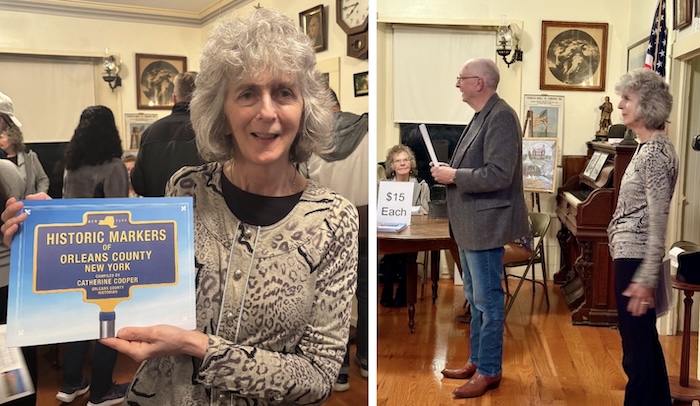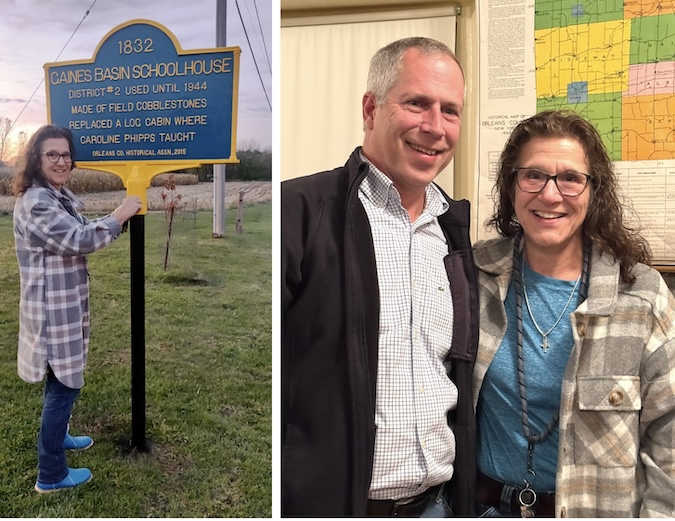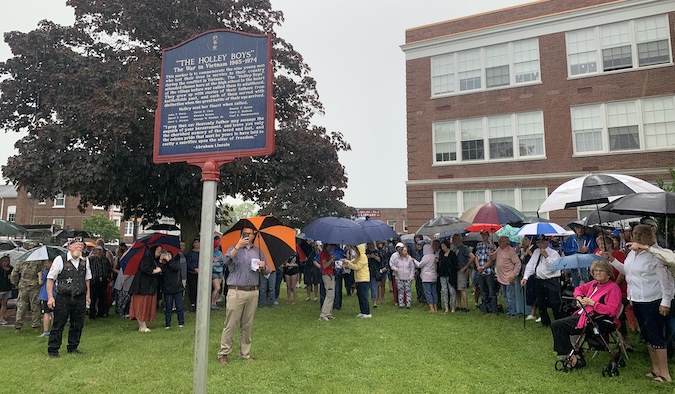Historian completes updated book on 105 historical markers in Orleans County

(Left) The book includes a tribute to Melissa Ierlan of Clarendon who has repainted more than 50 of the historic markers, often welcoming local students to help in the process of scraping off paint, and putting on a base coat before Ierlan puts on the final coats of blue and yellow paint and does painstaking process of painting each letter. She delivered one freshly repainted marker on Oct. 29. This was the marker for the Gaines Basin Cobblestone Schoolhouse which was built in 1832. (Right) Tim Archer, an Albion teacher, praised Ierlan for being “a tireless doer” in taking on so many of the projects.
By Ginny Kropf and Tom Rivers
GAINES – An updated book about historical markers in Orleans County features about 100 of the markers around the county.
Catherine Cooper, the county historian, compiled the book of markers, as well as historical tidbits from each of the 10 towns and four villages. She pushed to get the project done in 2025 as part of the county’s bicentennial.
“Historic Markers of Orleans County New York” is a revised guidebook from the 2001 original. That book, “Historic Markers Erected During the 20th Century in Orleans County New York,” was produced by then Orleans County Historian Bill Lattin and Neil Johnson, the village of Albion historian.
“To date, historic roadside markers document significant events in Orleans County history,” Cooper said. “These blue and yellow signs are easily recognizable, but sometimes difficult to read as we speed by.”
Cooper, during the Oct. 29 book unveiling, told her audience she suggested keeping a copy of the book in the car so the text on these markers – which enriches our connection to our surroundings – can easily be referred to.
The new book has the same design and layout as the first publication, Cooper said. It is organized by towns and has a chronology at the beginning. The signs cover the complete range of Orleans County history. Many of the signs refer to “firsts,” such as “first church,” or “first school,” since these were significant achievements at the time.
Other signs refer to people who made a difference, such as the sign for Col Ezra Brainard of Holley, who is credited with developing the idea of a triangular-shaped truss bridge construction during the early years of Erie Canal construction. Erie Canal bridges still feature truss supports, Cooper said.

Provided photos: Catherine Cooper, the Orleans County historian, holds a copy of a book featuring the historical markers in Orleans County. Cooper did a book launch during a presentation on Oct. 29 at the Gaines Basin Cobblestone Schoolhouse, which is the meeting place for the Orleans County Historical Association. Bill Lattin introduced Cooper and commended her efforts during the Oct. 29 presentation.
The book includes 105 historical markers. The Village of Albion has the most markers with 22, followed by the Town of Gaines with 19. The Village of Lyndonville has the fewest with 2, with the Town of Albion (outside the village), the next fewest with 3.
Here are the numbers in the other municipalities: Barre, 4; Carlton, 7; Clarendon, 7; Holley, 8; Kendall, 4; Medina, 9; Murray, 6; Ridgeway, 7; Shelby, 5; and Yates, 5.
This latest book is dedicated to Melissa Ierlan of Clarendon, who has repainted and repaired 54 of the historic marker signs. Tim Archer, retired Albion Social Service teacher, commended Irelan’s generosity of spirit and the enthusiasm she has passed on to student volunteers.
The back cover of the book features the poster created by Carol Culhane for the Orleans County bicentennial. The 58-page book also has a list of the 36 veterans’ memorials in the county.
Copies of the book are available for $15. They can be purchased at the Cobblestone Museum, Hoag Library, Lee-Whedon Memorial Library in Medina, Murray-Holley Historical Society and Author’s Note in Medina.
Bill Lattin spoke at the Oct. 29 book unveiling. He said historic markers are the “tip of the iceberg” in providing information about some of the important local sites.
“The historic markers are not just an arsenal of facts, but a living continuum through which we may better understand our lace in the world in which we live, much to our ‘tangible benefit,’” Lattin writes in the foreword of the book.

Photo by Tom Rivers: On May 27, 2024, on a rainy Memorial Day, the Holley community dedicated a new historical marker for the 9 “Holley Boys” who were killed during the Vietnam War. Those young men include: John P. Davis, age 30: David Duane Case, 20; Ronald P. Sisson, 23; Howard L. Bowen, 20; Gary E. Bullock, 24; Gary Lee Stymus, 26; George Warren Fischer Jr., 23; Paul Scott Mandracchia, 18; and David States, 21. This marker is much larger than the typical historical markers. It I located in front of the old Holley High School.
Since the 2001 book by Lattin and Johnson, about 30 more markers have been added to the Orleans County landscape.
The oldest marker was installed in 1913 as a tablet erected in front of the County Clerk’s Building in Albion. That marker told how the site previously was home to the Phipps Union Female Seminary led by the school’s founder, Caroline Phipps Achilles.
The early markers in the county were typically funded by the Daughters of the American Revolution and the State Historic Marker Program. More recent markers were spearheaded by local or historical agencies, Cooper said. And since 2012, the William G. Pomeroy Foundation has supported many of the markers.
Cooper thanked local highway departments for installing many of the markers, and volunteers who have repaired and repainted them, notably Melissa Ierlan of Clarendon, Dan Mawn of Holley and Larie Vagg of Albion.
The book of historical markers helps to understand Orleans County, which formed in 1825 after splitting off from Genesee County.
“Two hundred years is a short time in the span of history but a significant period in human terms,” Cooper writes in the foreword of the book. “The landscape is completely different. Lifestyles have changed dramatically in that time. It is the thread of history that connects us through the constant and inevitable change. Historic markers serves as guide marks along the way.”




































































